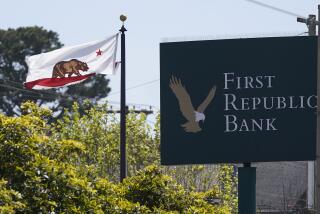Seize Ailing S&Ls;, GAO Chief to Urge : Action Would Limit Interest at 350 Thrifts
- Share via
WASHINGTON — The General Accounting Office, in a drastic proposal to deal with the thrift industry crisis, will recommend today that the government seize control of about 350 insolvent savings and loan associations to prevent them from offering unusually high rates of interest on deposits.
The ailing S&Ls; “must be effectively isolated” from the healthy segment of the industry, Comptroller General Charles A. Bowsher, the GAO’s director, will tell the Senate Banking Committee.
Under government control, the S&Ls; would be restricted to “investing in high-grade securities, managing bad assets (problem loans) on their books and accepting deposits at prevailing market rates,” according to Bowsher’s testimony, a copy of which was obtained by The Times.
Rates to Be Restricted
These crippled institutions would be forbidden from offering extraordinary interest rates to depositors and investing their money in risky real estate deals and other potentially dangerous ventures.
Failing institutions have commonly resorted to such practices to raise badly needed funds and to try to make substantial profits. Not only have these practices contributed to the size of the massive crisis in the industry, but they have also forced healthy S&Ls--about; 2,700 of the 3,000 federally insured institutions--to pay depositors high interest rates to compete with insolvent firms.
Government receivership is needed to prevent a further increase in the enormous price tag for cleaning up the crisis, Bowsher says in his prepared testimony. He estimates it will cost the government $85 billion to meet previous commitments to rescue failing S&Ls;, to close or sell the remaining insolvent institutions and to provide $20 billion to restore the fund that insures S&L; deposits up to $100,000.
Warns Against Delay
“Delay will only increase this cost,” according to Bowsher.
About 350 S&Ls;, according to federal regulators, have liabilities that exceed their assets. Under Bowsher’s plan, they would be operated by government personnel until regulators decided to shut them down and pay off depositors or else arranged sales to outside investors or healthy institutions.
The GAO plan, which says all insolvent S&Ls; should be seized within a year, would represent a dramatic departure from the current regulatory strategy of patching together complex deals to entice outside investors to buy crippled S&Ls.;
The Federal Home Loan Bank Board, which regulates the savings industry, arranged the shutdown or sale of more than 200 ailing S&Ls; last year by using promissory notes, tax credits and guarantees against losses on current investments to attract outside buyers.
If the federal S&L; insurance fund had the necessary cash, the bank board could simply have shut down many of these institutions and made good on the insured deposits. But the insurance fund has only $3 billion, far short of the billions that would have been needed for liquidation.
Bowsher, in his prepared testimony, is intensely critical of the flurry of December deals, which the bank board arranged just before the available tax advantages were sharply reduced as of Jan. 1.
New owners of the S&Ls; contributed “minimal” capital to their new enterprises, Bowsher says in his testimony. There is a danger, he says, that these S&Ls; may again “engage in unsafe and unsound management practices,” just as they did when they got into financial trouble in the first place.
Institutions Consolidated
The bank board frequently packaged groups of S&Ls; into a single enterprise for sale to investors. There is nothing, Bowsher notes, to prevent the newly consolidated thrift institutions from continuing to take deposits at high interest rates. And if they do, he warns, they will pose an even greater financial problem because of their enlarged capacity to wheel and deal.
Federal regulators, Bowsher says, face “a huge task in effectively administering these complex agreements” that stemmed from the December bailouts.
The GAO’s study of the December deals was requested by Senate Banking Committee Chairman Donald W. Riegle Jr. (D-Mich.), who has been critical of the bank board’s rush to complete sales before the year’s end. Riegle was particularly concerned that, for tax purposes, buyers could apply the losses from their S&Ls; to profits from other businesses.
Riegle also asked the GAO for its views on resolving the thrift crisis, and Bowsher offered a detailed and sweeping response. The GAO is the investigative arm of the Congress, and its comments previously have been limited to studies of the impact and cost of the crisis enveloping the federal S&L; insurance fund.
But in today’s testimony, respected GAO experts will go beyond analysis to recommendation, and their proposal is likely to win serious attention in the Banking Committee and elsewhere in Congress.
The Federal Savings and Loan Insurance Corp., the protector of S&L; deposits, should be bureaucratically separated from the Federal Home Loan Bank Board, which promotes and regulates the S&L; industry, according to the GAO.
More to Read
Inside the business of entertainment
The Wide Shot brings you news, analysis and insights on everything from streaming wars to production — and what it all means for the future.
You may occasionally receive promotional content from the Los Angeles Times.










